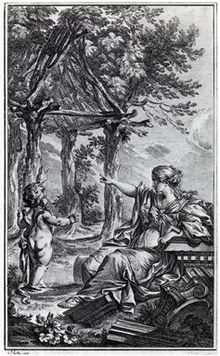Marc-Antoine Laugier

Marc-Antoine Laugier SJ (born September 26, 1713 in Manosque , Provence , † April 7, 1769 in Paris ) was a priest , man of letters , historian and architectural theorist .
Life
At the age of 14 he entered the Jesuit College in Avignon at the instigation of his parents . In the following years he studied theology in Lyon , Besançon , Marseille , Nîmes and Arles . On February 2, he took his religious vows in Paris and initially worked in the Church of St-Sulpice de Paris . A short time later he became court chaplain in Paris. In 1754 he preached a sermon to the king and court at Versailles during Lent . This became a public scandal. Laugier criticized the royal court for its lust for pleasure, wastefulness in the monarchy and for the moral way of life of the nobility. He also criticized the political conditions of his time violently. After his last sermon on Easter Sunday 1754, Laugier was called back to the provinces in Lyon by his superior . There he had to face disciplinary measures. In 1756 he switched to the order of the Benedictines . Due to his prehistory, Laugier was released from diocesan duties and devoted himself to art , architecture and music . In the following years he wrote various theoretical writings on architecture and art. On April 7, 1769, Laugier died in Paris after a brief illness.
Architectural theory
Laugier's Essai sur l'architecture (first published anonymously in 1753, 1755 under the name of the author), was one of the most widely read and translated treatises of the 18th century. It was not only aimed at the specialist public, but also at art lovers and lay people. Laugier wanted to put the architecture on a natural and sensible basis. Fundamental to the model of it already at Vitruv described primitive hut : four disposed at the corners of a square ground plan presented tree trunks, which are connected by four logs and a kind of saddle roof bear against each other provided branches. Translated into stone, these are the elements of the ancient temple with its pillars and the horizontal beams. According to Laugier, these essential elements alone create the beauty of a building. Walls or vaults, on the other hand, are only needs-based, as people cannot live in open pillared halls. Unnecessary ornamentation is to be omitted. Laugier's theory encouraged the fondness for the column and the colonnade in classicist architecture . Laugier propagates the use of "pure" forms and opposes the blurring of forms in the Baroque and Rococo . The then newly built church of Sainte-Geneviève, now the Panthéon (Paris) , largely corresponded to Laugier's ideas.
The idea of Laugier, according to which all types of buildings can be designed by placing identical four-pillar units behind, next to and on top of each other in the style of the original hut, is pioneering. Laugier propagates a serial architecture of always the same units, as it was only realized in the 19th century and in modern times.
For the construction of the church, Laugier demands the connection of the colonnade as a support system in the style of an ancient temple with the weightlessness and constructive audacity of Gothic vaults. He rates Gothic architecture positively, only rejecting its decorative forms as barbaric.
The Observations sur l'architecture (1765) go even further in appreciating the Gothic . Laugier can now imagine the interiors of churches based directly on the Gothic, although the individual forms need to be improved in the sense of classicism. In Germany, Laugier's ideas particularly influenced the architect Johann Carl Friedrich Dauthe when he redesigned the interior of the Nikolaikirche in Leipzig towards the end of the 18th century.
Works
-
Essai sur l'architecture. first published anonymously Paris 1753 ( digitized by Gallica ); under his name again in 1755 ( digitized at e-rara).
- English: An Essay on Architecture. In which its true principles are explained (...). London 1755 (digitized in the Internet Archive ).
- German: attempt on building art. Translated from the French by David Andreas Schneller. Frankfurt 1756.
- Current German edition: The Manifesto of Classicism. Artemis, Zurich 1989, ISBN 3-7608-8124-6 .
- Jugement d'un amateur sur l'exposition des tableaux (Lettre à M. le marquis de V ***). Paris 1753 (digitized by Gallica ).
- P. Laugier's attempt at a Jesuit in the art of architecture. Leipzig, Frankfurt (digitized in the SLUB ; written from 1758 to 1768 in Paris).
- Observations on the architecture. Paris 1765.
- Histoire des negociations pour la paix conclue à Belgrade, le September 18, 1739 entre l'Empereur, la Russie et la Porte Ottomane, par la médiation, et sous la garantie de la France (book article), published in volume II. Paris 1768
literature
- Françoise Fichet: Marc-Antoine Laugier. 1713-1769. In: dies .: La théorie architecturale à l'âge classique. Essai d'anthologie critique. Mardaga, Brussels et al. 1979, ISBN 2-87009-104-4 , pp. 367-369 (preview on Google Books).
- Claus Bernet : Marc-Antoine Laugier. In: Biographisch-Bibliographisches Kirchenlexikon (BBKL). Volume 21, Bautz, Nordhausen 2003, ISBN 3-88309-110-3 , Sp. 786-793.
| personal data | |
|---|---|
| SURNAME | Laugier, Marc-Antoine |
| ALTERNATIVE NAMES | Laugier, Marc Antoine |
| BRIEF DESCRIPTION | French clergyman, man of letters, historian and architectural theorist |
| DATE OF BIRTH | September 26, 1713 |
| PLACE OF BIRTH | Manosque |
| DATE OF DEATH | April 7, 1769 |
| Place of death | Paris |